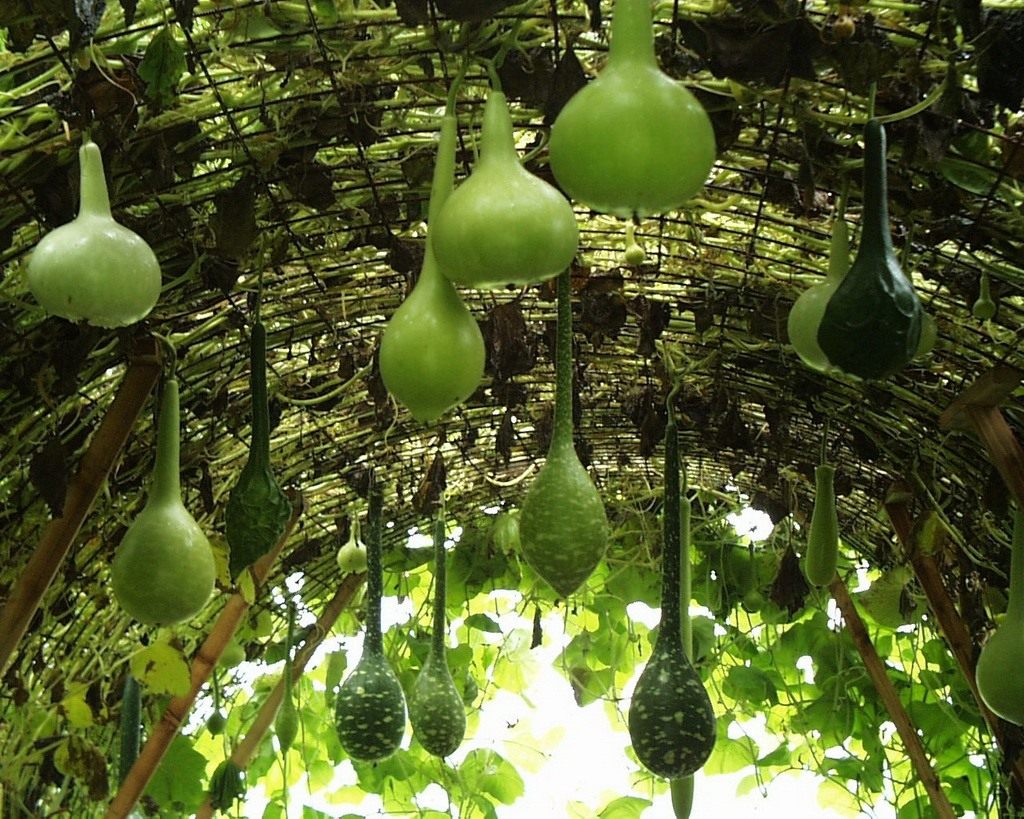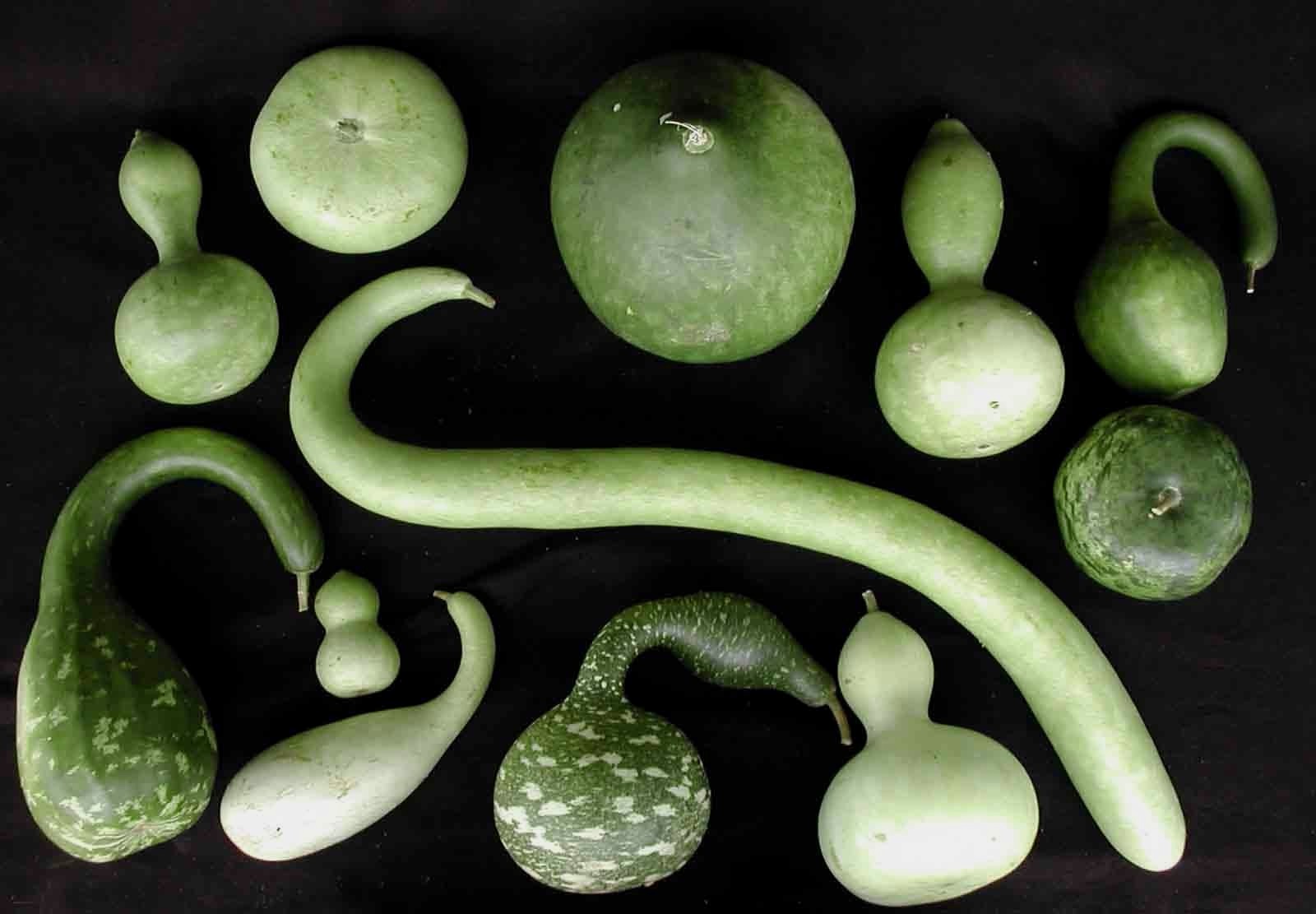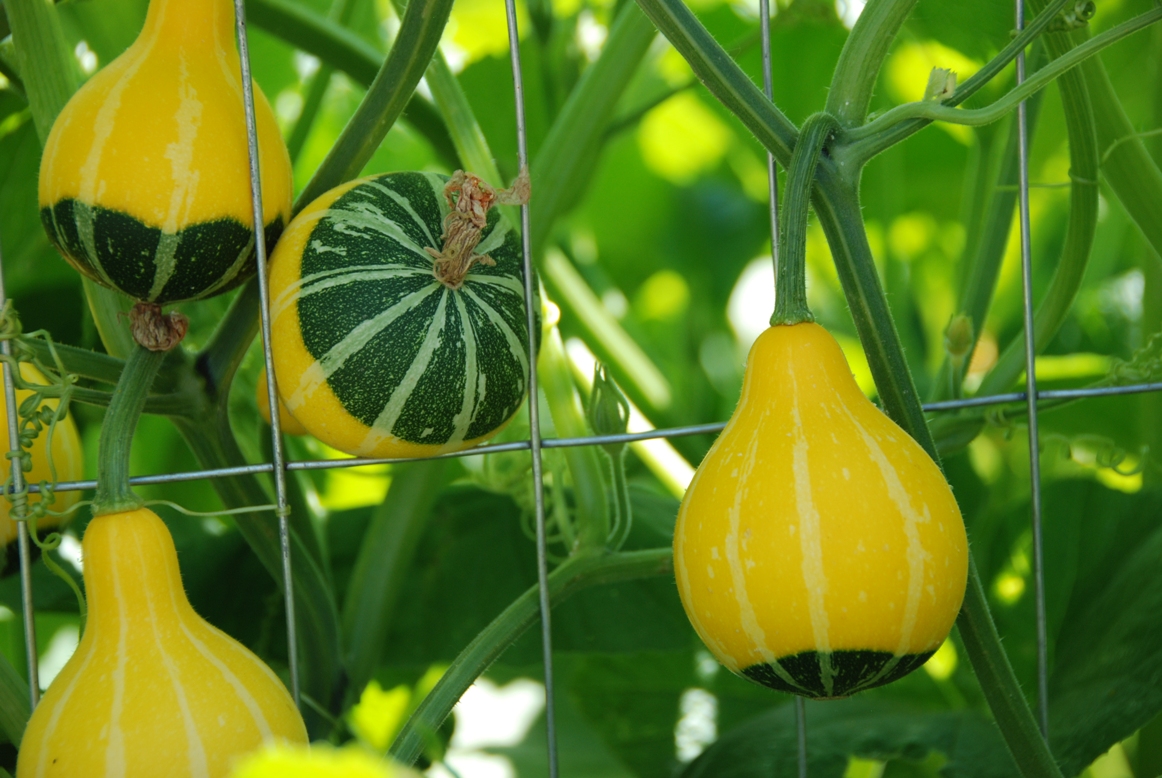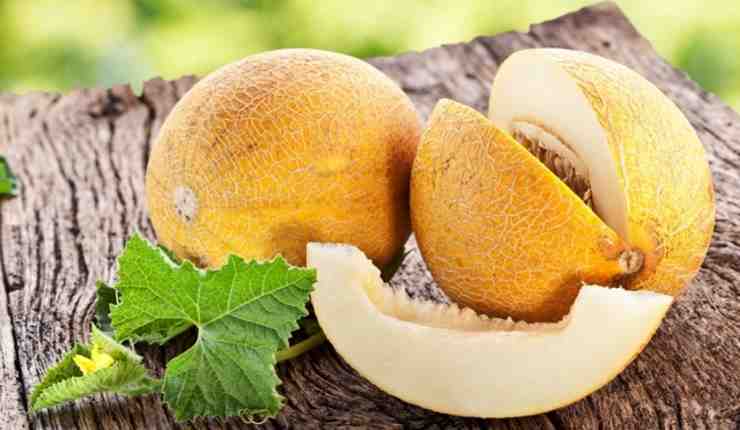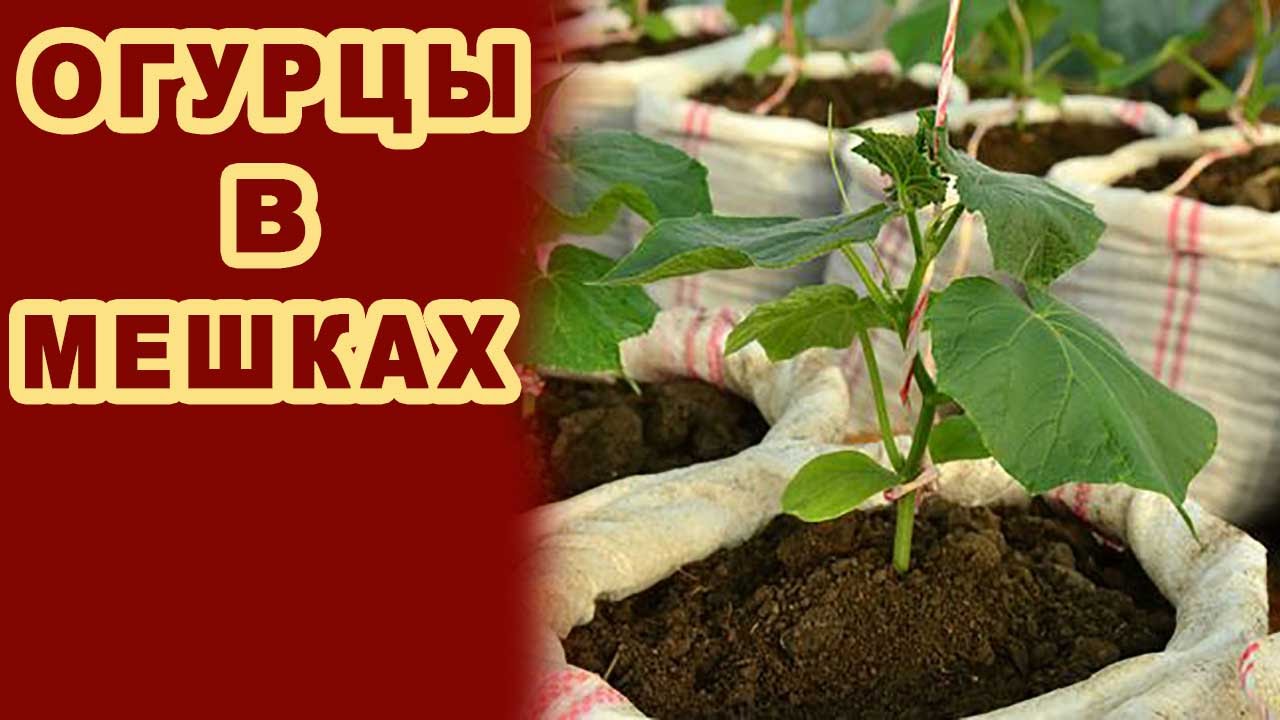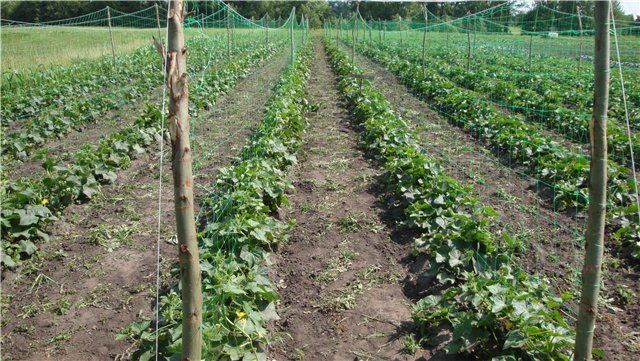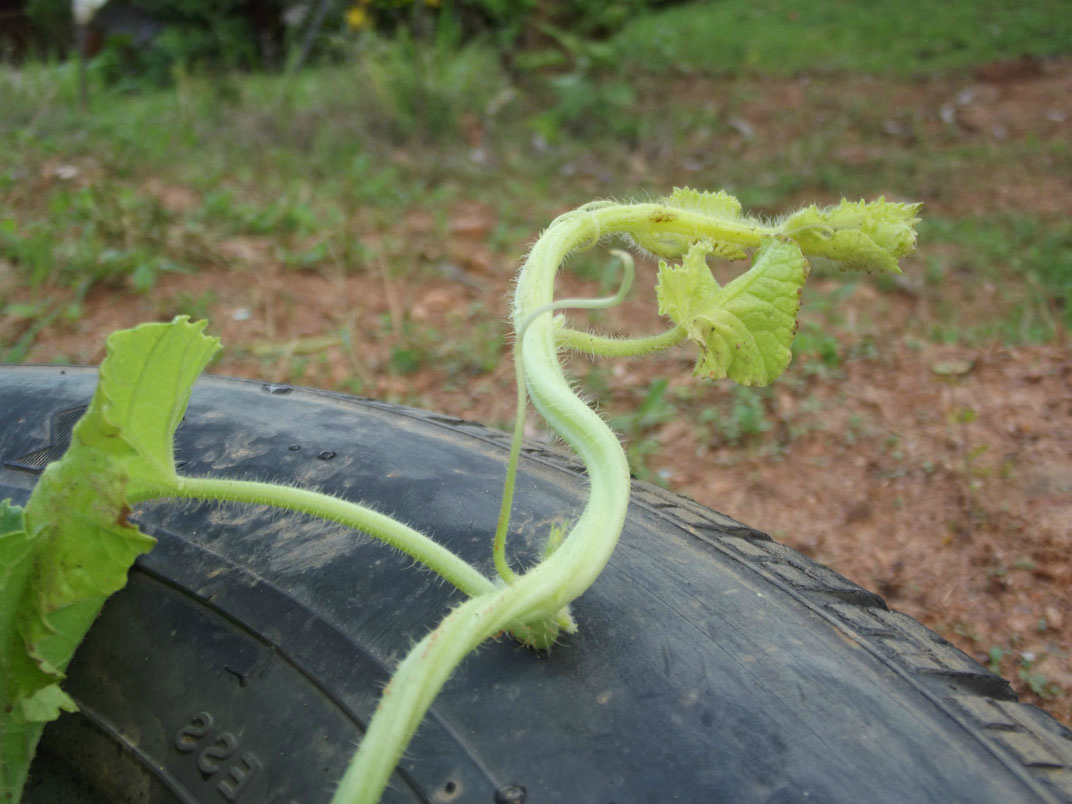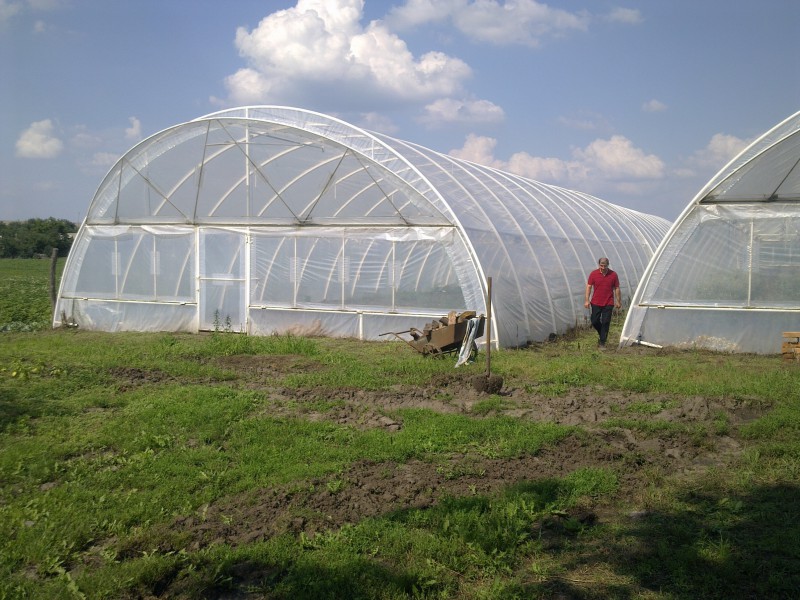Lagenaria belongs to the group of pumpkins that are small in size, which allows them to be grown at home. In the tropics, this plant is eaten, they make dishes and small crafts (toys, pipes for smoking, etc.) from it.
Description of the variety
- The vegetable harvest is obtained 150-210 days after germination.
- The stem length ranges from 10 to 15 m (liana).
- The leaves of the plant are rather large, covered with a small downy.
- The roots go down 0.8 m into the ground.
- Flowers are separated by sex, cross-pollinated. Their shape resembles a glass. They are painted white with a creamy sheen.
- Flowering and fruiting of lagenaria occurs simultaneously throughout the summer and until autumn.
The fruits are smooth to the touch, and some pumpkins are up to 2 m long. Ripe vegetables taste like zucchini, and unripe specimens taste like cucumbers.
Lagenaria grows well in the southern regions of Russia and in the middle zone of the country. It can withstand transportation over any distance. For culinary purposes, fruits are used with a diameter of no more than 50 mm and a length of almost 11-13 cm. Such pumpkins are used to create salad installations, fry, and make pancakes from them. For the winter, caviar is prepared from vegetables.
If it is supposed to use berries in decorative products, fully ripe fruits with a thick skin are harvested before the onset of frost. They can be painted, burned out patterns on the surface, varnished.
The most popular types of pumpkin are:
- Long-fruited lagenaria, or Lucertola. Of all types of culture, this hybrid has the greatest ability to regenerate. The shape of the fruit (its length reaches 180-200 cm) and its taste make it possible to use this variety for cooking due to the possibility of gradually cutting off pieces of the desired size without removing the entire pumpkin. In the cut off place, the flesh hardens, and the berry continues to grow. The plant on the site must be placed in a place that is as illuminated as possible by the sun.
For the pumpkin to develop normally, the air temperature must be maintained at + 15 ° -19 ° C. Without these conditions, the fruit grows slowly. - Lagenaria polnovidnaya differs from other varieties of berries, reminiscent of even, long cylinders. The weight of each of them is within 10-15 kg.
- Lagenaria serpentine (cobra) has an elongated fruit colored in dark green tones, then develops into a formation similar to a viper's cloak.
- Vegetable variety Goose in apples is considered the most unpretentious. Its berries are like a water bird. Gardeners love to color these pumpkins and use them in decorative items to decorate their plot.
- The club-shaped type of Lagenaria looks like a bottle, in which the lower part is thickened, and the neck is narrow and long. The volume of such a fruit can reach 2-3 liters.
- Calabaza resembles Lagenaria Serpentine (cobra) in shape, but the pumpkin is painted in light colors.
Which of the varieties to plant on the site is chosen by the farmer himself. In order not to make mistakes when growing a vegetable, you need to familiarize yourself with some of the rules that will be given below.
How to grow lagenaria from seeds
If a lagenaria is planted in the garden, the cultivation of the crop begins with the acquisition of seed. It is better to do this in company stores.
To provide them with a good germination percentage, it is recommended to start germinating lagenaria seeds as follows:
- All seed material is kept in solutions that stimulate growth (for example, "Ellin") for 48 hours. For these purposes, you can also use home remedies (aloe juice).
- Then, for 5-6 days, the seeds are placed in any moist environment (wet wipes, Sfagnum moss, sawdust moistened with water).
In the room where the seed fund is supposed to germinate, the temperature is maintained at 23-24 ° C. After 3 days, the seeds swell. You can transfer them to the ground or pre-obtain seedlings by sprouting on moistened gauze folded in 4-5 layers. In order not to make picking of seedlings for germination of sprouts to the desired condition, glasses with a volume of 800 to 1000 ml, made of plastic, are used.
Swollen seeds of lagenaria must be germinated in a mixture of peat, river sand and humus. To obtain soil, these components are taken in different proportions. The following conditions must be met:
- For each plastic cup, 1 seed is sown, which is deepened into the described mixture by 20-25 mm.
- The soil layer is moistened abundantly.
- The sprouts will grow under cling film or glass in a warm room.
The gardener must constantly monitor the crops. When green sprouts appear, the film is removed, and glasses with them are placed on the windowsill on the south side of the apartment. Seedlings are watered with water (it should be kept in the sun) as the soil underneath dries out.
When pulling the sprouts, pour the soil mixture into the cups. Approximately a week before transplanting the seedlings into the garden, they are hardened.
Cultivation in Russian conditions begins in mid-April, the culture is bred in pots. The seed placement depth is 30 mm. The seeds are pre-germinated by soaking them in water for 24 hours. Then they are placed in sawdust moistened with water. The seeds are there until the roots appear at a temperature of 24 ° C. With proper care, the germination rate of the culture exceeds 70%. Those specimens that have not sprouted for any reason must be removed and destroyed.
Agrotechnics
For different types of plants, this process has certain differences.
Growing and caring for lagenaria in open ground in central Russia involves placing the plant in a well-warmed area by the sun. In this case, it is recommended to use good supports. An arch is made where the vine is hooked. Or a strong trellis is used. The cultivation of the culture is carried out as follows:
- Dig holes measuring 0.5 X 0.5 X 0.5 m at a distance of 70 cm to 1.0 m from each other.
- They fill the resulting pits with humus or compost, fall asleep up to 2 tbsp. fly ash.
- Sprouts with a lump of soil are removed from plastic pots. Planting each specimen with due care in a separate hole.
In order for the seedlings to start growing, the soil layer is sprayed with warm, settled water.
Lagenaria serpentine, the cultivation of which does not differ from similar events for other types of pumpkin, requires more space for sprouts. To plant her seedlings and grow them normally, 100 X 100 cm of area is allocated for each copy. 2-3 bottoms of the sprouts are shaded, watered with warm water, mulch the upper soil layer with humus or peat.
When growing lagenaria serpentine from seeds, seedlings are covered before flowering so that they do not suffer from the cold. When the bushes grow up to 100 cm, they are tied to supports. When the stem and branches are 2 m long, they must be pinched.
Lagenaria is field-like, cultivation and care of which is carried out in the same way as for other types of vegetables, requires an area of 2.5 X 2.5 m for its fruits.This type of pumpkin, like other subspecies, must be fed every 14 days with organic (mullein, manure) or mineral (superphosphate) fertilizers. Periodically growing specimens are watered with warm water, to which wood ash is added (2 tbsp.8 liters of liquid). Each plant takes 0.5 liters of such a solution during the development of the liana, and during the formation of ovaries, it is required to water each vegetable with 2000 ml of the mixture.
Pollination of plants is best done manually. For this, male flowers are plucked, and then their stamens are carried along the stigmas of female counterparts. For the procedure, cotton pads are also used.
Novice gardeners are wondering why lagenaria does not arise. Most often this happens due to the purchase of substandard seeds or a violation of the technology for obtaining seedlings by the seedling method. Perhaps the temperature in the room is not maintained, where sprouts emerge from the seeds. Sometimes damage to the plant occurs when it is transferred to a permanent place.
Knowing how to grow lagenaria from seeds, it will not be difficult to get a rich harvest of a useful crop.
